Wind Turbine Blade Damage Evaluation under Multiple Operating Conditions and Based on 10-Min SCADA Data
Abstract
1. Introduction
2. Resources and Hypothesis
2.1. Resources
2.2. Environmental Effects Affecting the Wind Turbine Damage
2.3. Operating Regimes
2.4. Hypothesis
3. Steady Regime Damage
3.1. Stress Assessment
3.2. Assessment of Damage Based on 10-Min SCADA Data and 1 Hz Simulated WS Signal for Continuous Regimes
3.3. Assessment of the Damage Based on 10-Min SCADA Data and 1 Hz Simulated WS Signal for Transient Regimes
4. Results and Discussion
5. Conclusions
Author Contributions
Funding
Data Availability Statement
Conflicts of Interest
Nomenclature
| Symbol | Description of the parameters |
| Characteristic short-term structural member resistance for tension | |
| Characteristic short-term structural member resistance for compression | |
| Mean value of characteristic cycles | |
| Amplitude of characteristic cycles | |
| Slope parameter of S/N curve | |
| Vacuum infusion molding effect | |
| Post-cure polymerization effect | |
| Temperature effect | |
| Non-woven unidirectional fiber effect | |
| Post-cure polymerization effect | |
| Local safety factor at the trailing edge | |
| Ageing effect | |
| Temperature effect |
References
- DNV GL Energy Transition Outlook. DNV GL’s Energy Transition Outlook 2020. 2020. Available online: https://eto.dnvgl.com/2020/index.html (accessed on 4 December 2020).
- Zhu, C.; Li, Y.; Zhu, C.; Li, Y. Reliability Analysis of Wind Turbines; IntechOpen: London, UK, 2018. [Google Scholar] [CrossRef]
- Li, H.; Peng, W.; Huang, C.-G.; Guedes Soares, C. Failure Rate Assessment for Onshore and Floating Offshore Wind Turbines. JMSE 2022, 10, 1965. [Google Scholar] [CrossRef]
- Mishnaevsky, L. Repair of wind turbine blades: Review of methods and related computational mechanics problems. Renew. Energy 2019, 140, 828–839. [Google Scholar] [CrossRef]
- Technology Roadmap: Wind Energy 2013; IEA: Paris, France, 2013.
- Ciang, C.C.; Lee, J.-R.; Bang, H.-J. Structural health monitoring for a wind turbine system: A review of damage detection methods. Meas. Sci. Technol. 2008, 19, 122001. [Google Scholar] [CrossRef]
- Almond, D.P.; Avdelidis, N.P.; Bendada, H.; Ibarra-Castanedo, C.; Maldague, X.; Kenny, S. Structural Integrity Assessment of Materials by Thermography. In Proceedings of the Conference on Damage in Composite Materials, Stuttgart, Germany, 18–19 September 2006. [Google Scholar]
- Sørensen, B.F.; Lading, L.; Sendrup, P.; McGugan, M.; Debel, C.P.; Kristensen, O.J.D.; Larsen, G.C.; Hansen, A.M.; Rheinländer, J.; Rusborg, J.; et al. Fundamentals for Remote Structural Health Monitoring of Wind Turbine Blades—A Pre-Project; Risø National Laboratory: Roskilde, Denmark, 2002. [Google Scholar]
- Jørgensen, E.R.; Borum, K.K.; McGugan, M.; Thomsen, C.L.; Jensen, F.M. Full Scale Testing of Wind Turbine Blade to Failure—Flapwise Loading; U.S. Department of Energy: Oak Ridge, TN, USA, 2004. [Google Scholar]
- Nielsen, J.S.; Sørensen, J.D. Bayesian Estimation of Remaining Useful Life for Wind Turbine Blades. Energies 2017, 10, 664. [Google Scholar] [CrossRef]
- Asgarpour, M.; Sørensen, J.D. Bayesian based Prognostic Model for Predictive Maintenance of Offshore Wind Farms. Int. J. Progn. Health Manag. 2018, 9, 10. [Google Scholar] [CrossRef]
- Eder, M.A.; Chen, X. FASTIGUE: A computationally efficient approach for simulating discrete fatigue crack growth in large-scale structures. Eng. Fract. Mech. 2020, 233, 107075. [Google Scholar] [CrossRef]
- Liu, P.F.; Chen, H.Y.; Wu, T.; Liu, J.W.; Leng, J.X.; Wang, C.Z.; Jiao, L. Fatigue Life Evaluation of Offshore Composite Wind Turbine Blades at Zhoushan Islands of China Using Wind Site Data. Appl. Compos. Mater. 2023, 30, 1097–1122. [Google Scholar] [CrossRef]
- Chen, Y.; Wu, D.; Li, H.; Gao, W. Quantifying the fatigue life of wind turbines in cyclone-prone regions. Appl. Math. Model. 2022, 110, 455–474. [Google Scholar] [CrossRef]
- Sanchez, H.; Sankararaman, S.; Escobet, T.; Puig, V.; Frost, S.; Goebel, K. Analysis of two modeling approaches for fatigue estimation and remaining useful life predictions of wind turbine blades. In Proceedings of the PHM Society European Conference, Bilbao, Spain, 5–8 July 2016; Volume 11. [Google Scholar]
- Jiang, Z.; Moan, T.; Gao, Z. A Comparative Study of Shutdown Procedures on the Dynamic Responses of Wind Turbines. J. Offshore Mech. Arct. Eng. 2015, 137, 011904. [Google Scholar] [CrossRef]
- Jang, Y.J.; Choi, C.W.; Lee, J.H.; Kang, K.W. Development of fatigue life prediction method and effect of 10-minute mean wind speed distribution on fatigue life of small wind turbine composite blade. Renew. Energy 2015, 79, 187–198. [Google Scholar] [CrossRef]
- Germanischer Lloyd. Guideline for the Certification of Wind Turbine; Germanischer Lloyd: Hamburg, Germany, 2010; Volume 384. [Google Scholar]
- Bergami, L.; Gaunaa, M. Analysis of aeroelastic loads and their contributions to fatigue damage. J. Phys Conf. Ser. 2014, 555, 012007. [Google Scholar] [CrossRef]
- Marín, J.C.; Barroso, A.; París, F.; Cañas, J. Study of fatigue damage in wind turbine blades. Eng. Fail. Anal. 2009, 16, 656–668. [Google Scholar] [CrossRef]
- Vera-Tudela, L.; Kühn, M. Analysing wind turbine fatigue load prediction: The impact of wind farm flow conditions. Renew. Energy 2017, 107, 352–360. [Google Scholar] [CrossRef]
- Tibaldi, C.; Henriksen, L.C.; Hansen, M.H.; Bak, C. Wind turbine fatigue damage evaluation based on a linear model and a spectral method: Wind turbine fatigue damage evaluation. Wind. Energy 2016, 19, 1289–1306. [Google Scholar] [CrossRef]
- Ragan, P.; Manuel, L. Comparing Estimates of Wind Turbine Fatigue Loads Using Time-Domain and Spectral Methods. Wind. Eng. 2007, 31, 83–99. [Google Scholar] [CrossRef]
- IEC 61400-1; Wind Turbines Part 1: Design Requirements. International Electrotechnical Commission: London, UK, 2005.
- Valeti, B.; Pakzad, S.N. Estimation of Remaining Useful Life of a Fatigue Damaged Wind Turbine Blade with Particle Filters. In Dynamics of Civil Structures; Pakzad, S., Ed.; Springer International Publishing: Cham, Switzerland, 2019; Volume 2, pp. 319–328. [Google Scholar] [CrossRef]
- IEC 61400-12-1 Ed. 2.0 b:2017; Wind Energy Generation Systems—Part 12-1: Power Performance Measurements of Electricity Producing Wind Turbines. International Electrotechnical Commission: London, UK, 2017.
- Jiang, Z.; Xing, Y. Load mitigation method for wind turbines during emergency shutdowns. Renew. Energy 2022, 185, 978–995. [Google Scholar] [CrossRef]
- Kaimal, J.C.; Wyngaard, J.C.J.; Izumi, Y.; Coté, O.R. Spectral characteristics of surface-layer turbulence. Q. J. R. Meteorol. Soc. 1972, 98, 563–589. [Google Scholar]
- Jonkman, B.J.; Buhl, M.L. TurbSim User’s Guide; Technical Report; National Renewable Energy Lab. (NREL): Golden, CO, USA, 2006. [Google Scholar]
- POWER|Data Access Viewer. Available online: https://power.larc.nasa.gov/data-access-viewer/ (accessed on 8 February 2024).
- Dykes, K.L.; Rinker, J. WindPACT Reference Wind Turbines; National Renewable Energy Lab. (NREL): Golden, CO, USA, 2018. [Google Scholar] [CrossRef]
- Jonkman, J.; Butterfield, S.; Musial, W.; Scott, G. Definition of a 5-MW Reference Wind Turbine for Offshore System Development; National Renewable Energy Lab. (NREL): Golden, CO, USA, 2009. [Google Scholar] [CrossRef]
- Hawileh, R.A.; Abu-Obeidah, A.; Abdalla, J.A.; Al-Tamimi, A. Temperature effect on the mechanical properties of carbon, glass and carbon–glass FRP laminates. Constr. Build. Mater. 2015, 75, 342–348. [Google Scholar] [CrossRef]
- Hu, W.; Chen, W.; Wang, X.; Jiang, Z.; Wang, Y.; Verma, A.S.; Teuwen, J.J. A computational framework for coating fatigue analysis of wind turbine blades due to rain erosion. Renew. Energy 2021, 170, 236–250. [Google Scholar] [CrossRef]
- Barnes, R.H.; Morozov, E.V.; Shankar, K. Improved methodology for design of low wind speed specific wind turbine blades. Compos. Struct. 2015, 119, 677–684. [Google Scholar] [CrossRef]
- Damkilde, L.; Larsen, T.J.; Walbjørn, J.; Sørensen, J.D.; Kirt, R.; Plauborg, J.; Lübbert, M.; Karatzas, V. Wind Turbine Blades Handbook; Bladena: Copenhagen, Danemark, 2017. [Google Scholar]
- Manwell, J.F.; McGowan, J.G.; Rogers, A.L. Wind Energy Explained; John Wiley & Sons: Hoboken, NJ, USA, 2009. [Google Scholar]
- Joncas, S. Thermoplastic Composite Wind Turbine Blades. Ph.D. Thesis, TU Delft Library, Delft, The Netherlands, 2010. [Google Scholar]
- Hackl, C.M. Funnel control for wind turbine systems. In Proceedings of the 2014 IEEE Conference on Control Applications (CCA), Juan Les Antibes, France, 8–10 October 2014; pp. 1377–1382. [Google Scholar] [CrossRef]
- Jonkman, J.M.; Buhl, M.L., Jr. FAST User’s Guide—Updated August 2005; National Renewable Energy Lab. (NREL): Golden, CO, USA, 2005. [Google Scholar] [CrossRef]
- Luan, C.; Moan, T. On Short-Term Fatigue Analysis for Wind Turbine Tower of Two Semi-Submersible Wind Turbines Including Effect of Startup and Shutdown Processes. J. Offshore Mech. Arct. Eng. 2021, 143, 012003. [Google Scholar] [CrossRef]
- Zárate-Miñano, R.; Anghel, M.; Milano, F. Continuous wind speed models based on stochastic differential equations. Appl. Energy 2013, 104, 42–49. [Google Scholar] [CrossRef]
- Kong, C.; Kim, T.; Han, D.; Sugiyama, Y. Investigation of fatigue life for a medium scale composite wind turbine blade. Int. J. Fatigue 2006, 28, 1382–1388. [Google Scholar] [CrossRef]
- Bortolotti, P.; Tarres, H.C.; Dykes, K.L.; Merz, K.; Sethuraman, L.; Verelst, D.; Zahle, F. IEA Wind TCP Task 37: Systems Engineering in Wind Energy—WP2.1 Reference Wind Turbines; National Renewable Energy Lab. (NREL): Golden, CO, USA, 2019. [Google Scholar]
- Yi, W.; Lu, Z.; Hao, J.; Zhang, X.; Chen, Y.; Huang, Z. A Spectrum Correction Method Based on Optimizing Turbulence Intensity. Appl. Sci. 2021, 12, 66. [Google Scholar] [CrossRef]
- Hong, X.; Li, J. Stochastic Fourier spectrum model and probabilistic information analysis for wind speed process. J. Wind. Eng. Ind. Aerodyn. 2018, 174, 424–436. [Google Scholar] [CrossRef]
- Cheynet, E.; Jakobsen, J.B.; Obhrai, C. Spectral characteristics of surface-layer turbulence in the North Sea. Energy Procedia 2017, 137, 414–427. [Google Scholar] [CrossRef]
- Couche Limite Atmosphérique—Centre National de Recherches Météorologiques. Available online: https://www.umr-cnrm.fr/spip.php?rubrique186 (accessed on 6 March 2023).
- Chou, J.-S.; Chiu, C.-K.; Huang, I.-K.; Chi, K.-N. Failure analysis of wind turbine blade under critical wind loads. Eng. Fail. Anal. 2013, 27, 99–118. [Google Scholar] [CrossRef]
- Li, J.; Wang, J.; Zhang, L.; Huang, X.; Yu, Y. Study on the Effect of Different Delamination Defects on Buckling Behavior of Spar Cap in Wind Turbine Blade. Adv. Mater. Sci. Eng. 2020, 2020, 6979636. [Google Scholar] [CrossRef]
- Murdy, P.; Hughes, S.; Barnes, D. Characterization and repair of core gap manufacturing defects for wind turbine blades. J. Sandw. Struct. Mater. 2022, 24, 2083–2100. [Google Scholar] [CrossRef]
- Sun, Z.; Sessarego, M.; Chen, J.; Shen, W.Z. Design of the OffWindChina 5 MW Wind Turbine Rotor. Energies 2017, 10, 777. [Google Scholar] [CrossRef]
- Hiebel, M.; Schlipf, D. Case Study: D50 Offshore Wind Turbine; Aerodyn Engineering: Puchong, Malaysia, 2018. [Google Scholar]
- We Are LM Wind Power—The Leading Rotor Blade Supplier to the Wind Industry|LM Wind Power. Available online: https://www.lmwindpower.com/ (accessed on 8 March 2023).
- Rainflow Counts for Fatigue Analysis—MATLAB Rainflow. Available online: https://www.mathworks.com/help/signal/ref/rainflow.html?searchHighlight=C#d123e146736 (accessed on 13 April 2022).
- Kim, D.-Y.; Kim, Y.-H.; Kim, B.-S. Changes in wind turbine power characteristics and annual energy production due to atmospheric stability, turbulence intensity, and wind shear. Energy 2021, 214, 119051. [Google Scholar] [CrossRef]
- Chrétien, A.; Tahan, A.; Cambron, P.; Oliveira-Filho, A. Operational Wind Turbine Blade Damage Evaluation Based on 10-min SCADA and 1 Hz Data. Energies 2023, 16, 3156. [Google Scholar] [CrossRef]
- Kollar, L.P.; Springer, G.S. Mechanics of Composite Structures; Cambridge University Press: Cambridge, UK; New York, NY, USA, 2003. [Google Scholar]
- Pape, M.; Kazerani, M. Turbine Startup and Shutdown in Wind Farms Featuring Partial Power Processing Converters. IEEE Open Access J. Power Energy 2020, 7, 254–264. [Google Scholar] [CrossRef]
- Requate, N.; Meyer, T.; Hofmann, R. From wind conditions to operational strategy: Optimal planning of wind turbine damage progression over its lifetime. Dynamics and control/Wind turbine control. Wind. Energy Sci. Discuss. 2022, 8, 1727–1753. [Google Scholar] [CrossRef]
- Movaghghar, A.; Lvov, G.I. A Method of Estimating Wind Turbine Blade Fatigue Life and Damage using Continuum Damage Mechanics. Int. J. Damage Mech. 2012, 21, 810–821. [Google Scholar] [CrossRef]
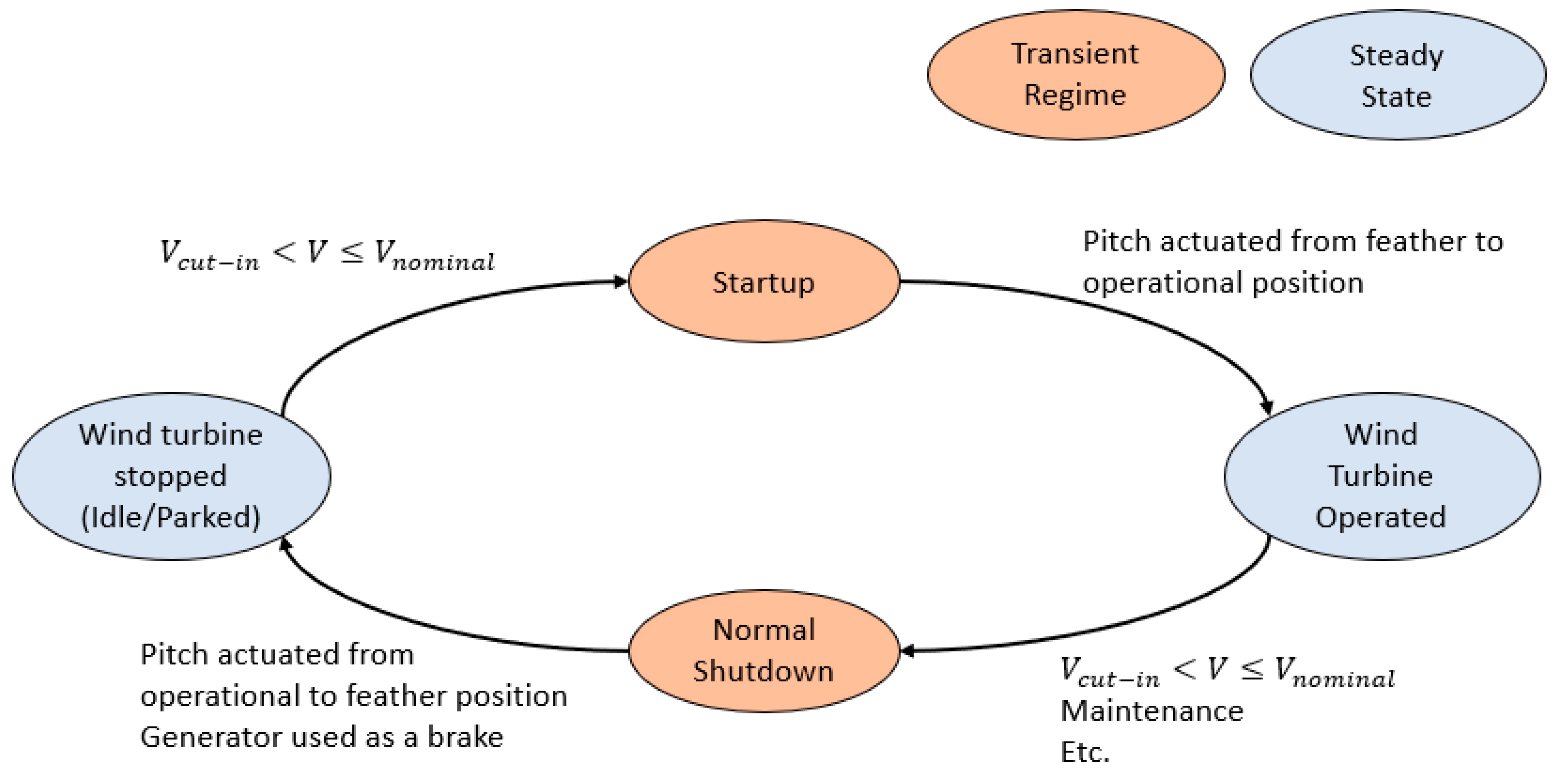


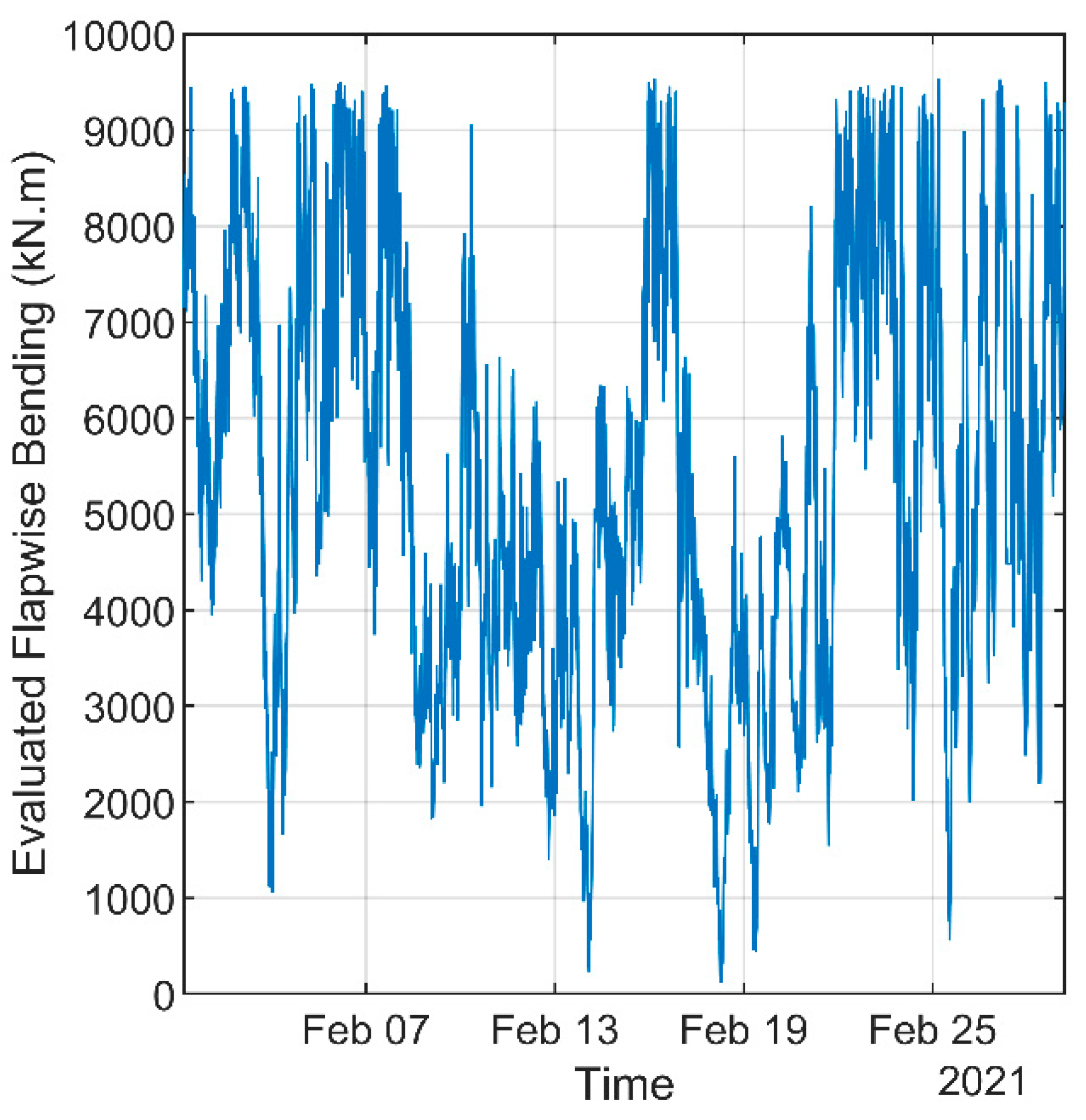

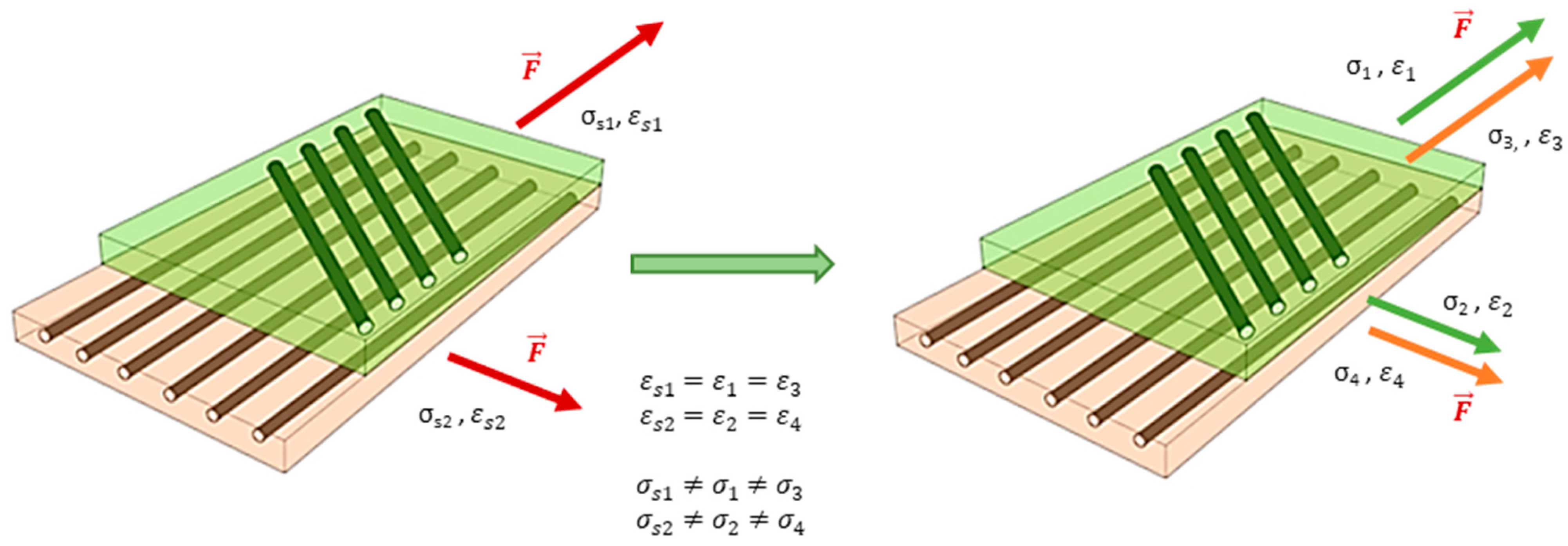
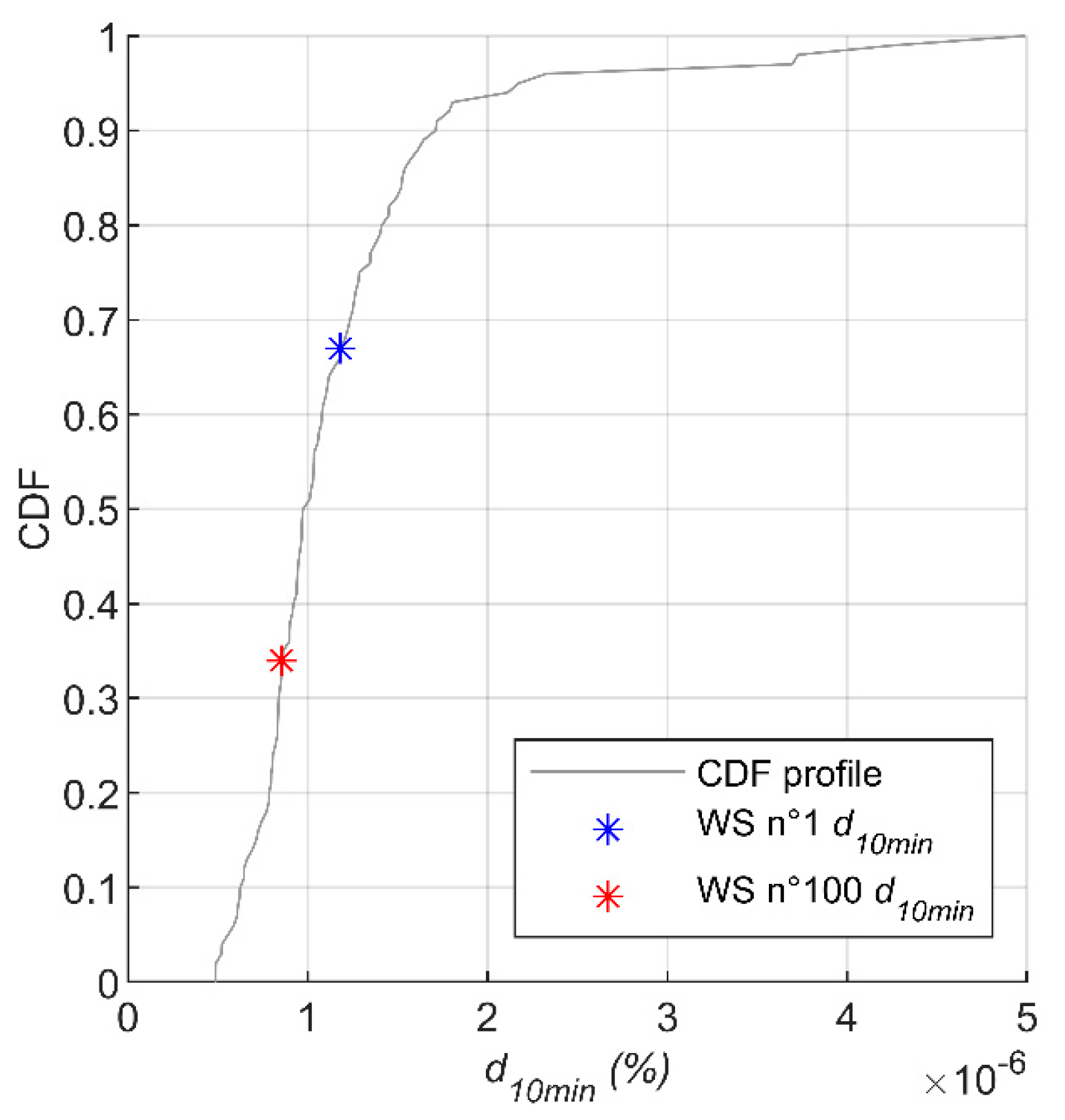
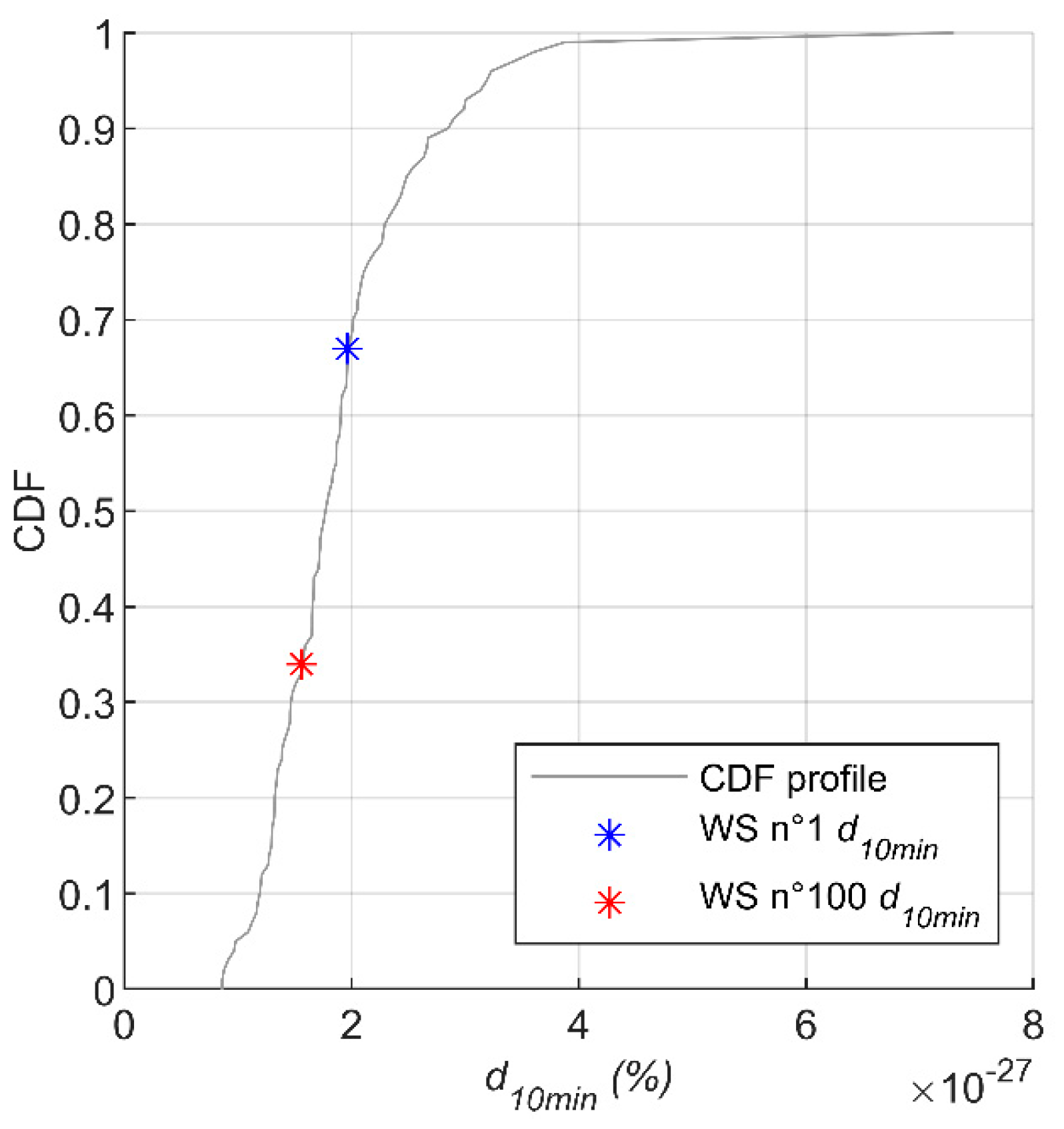
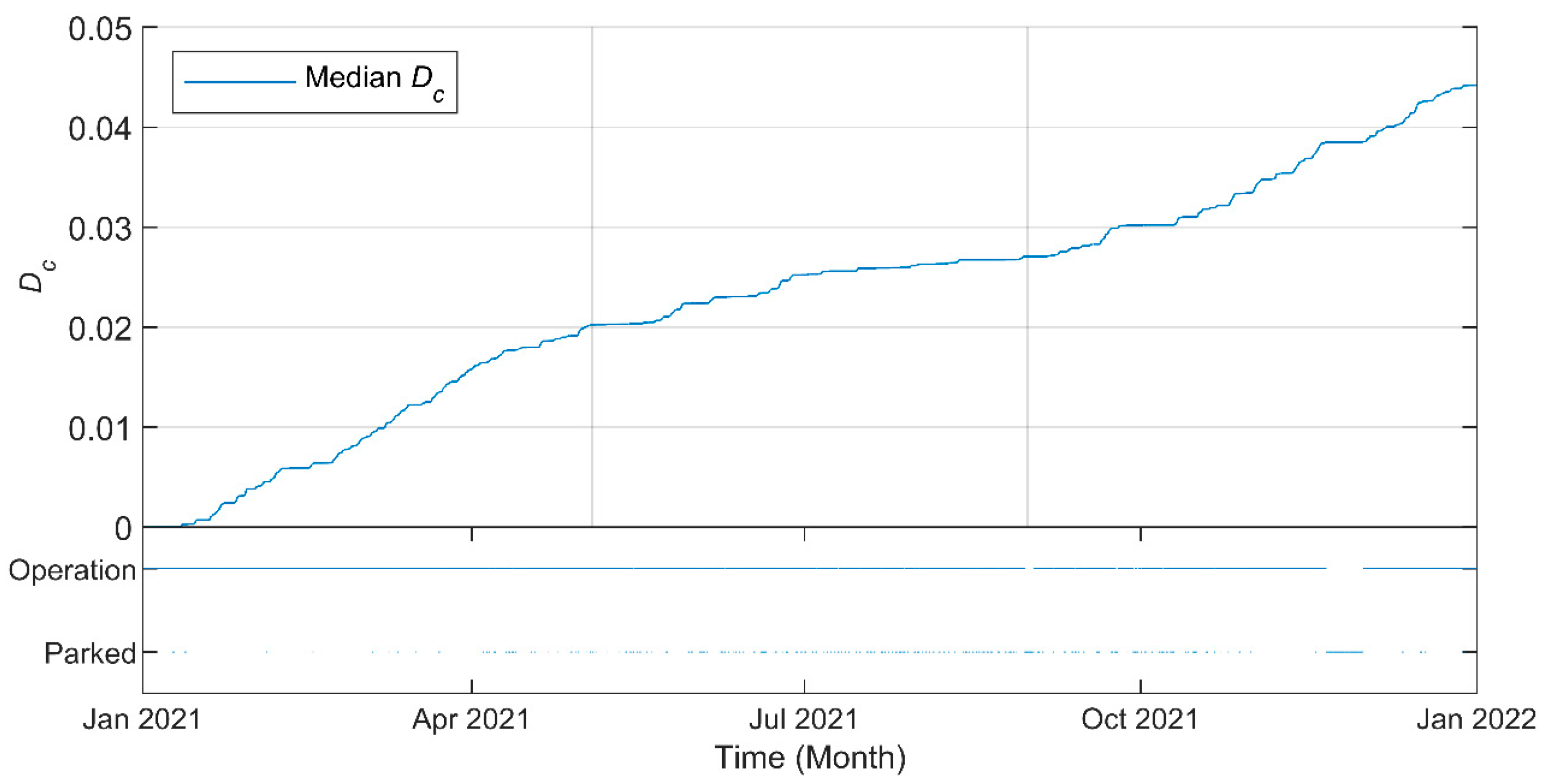
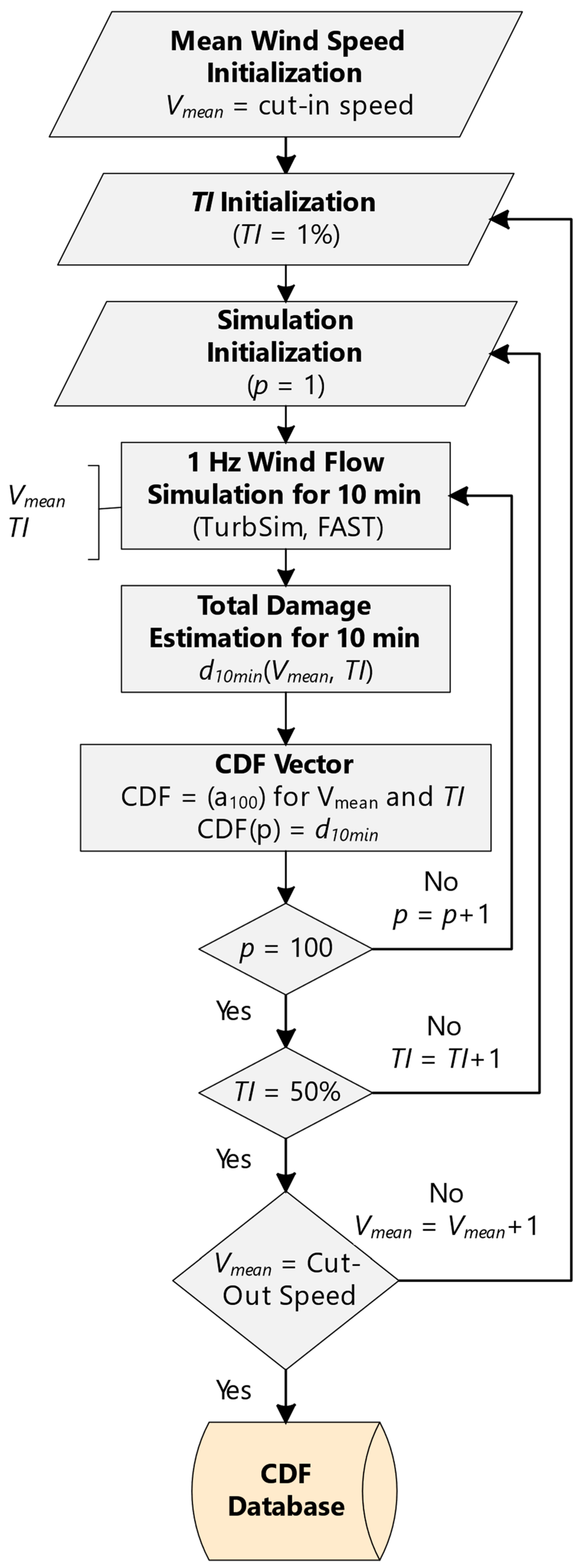
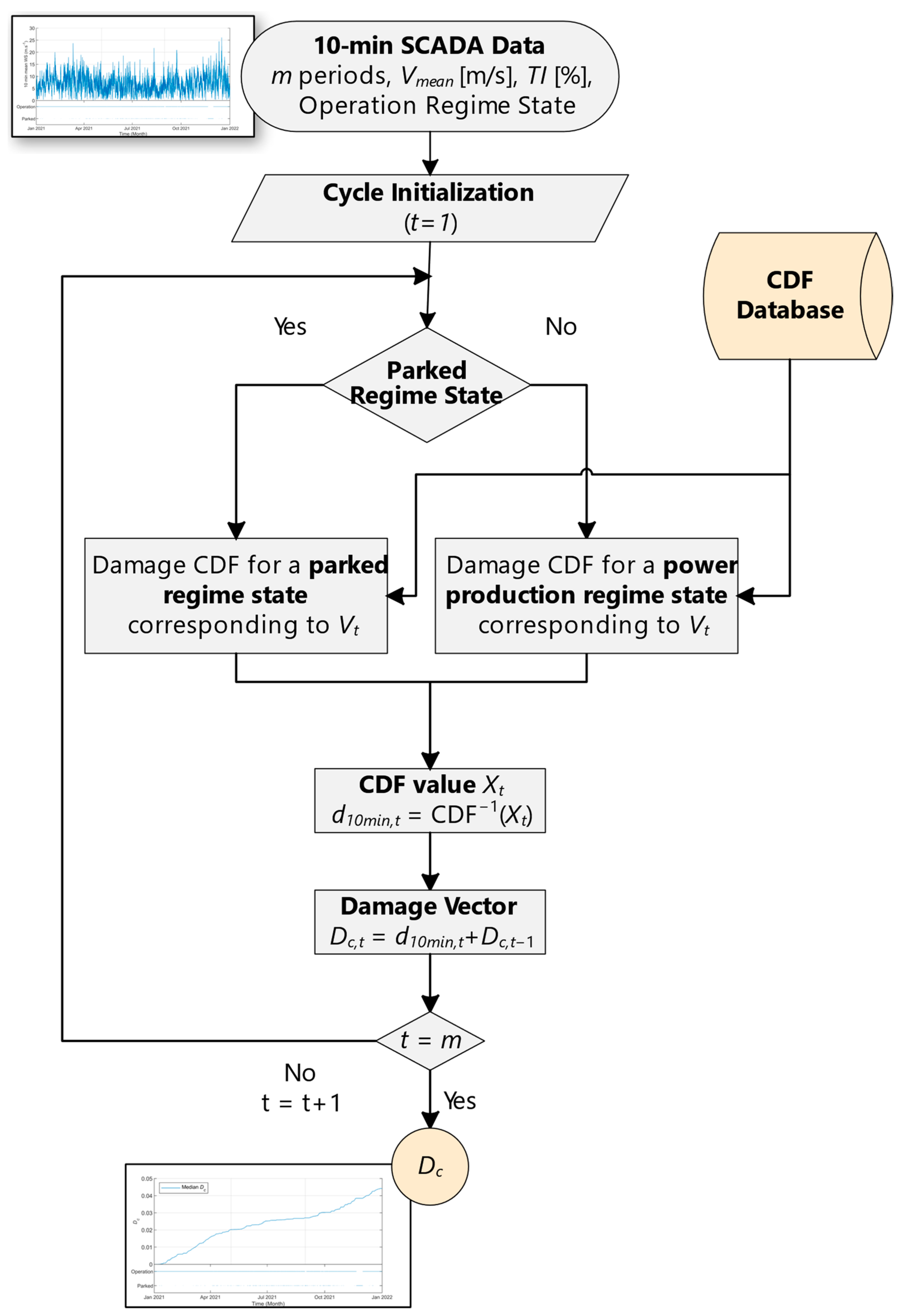
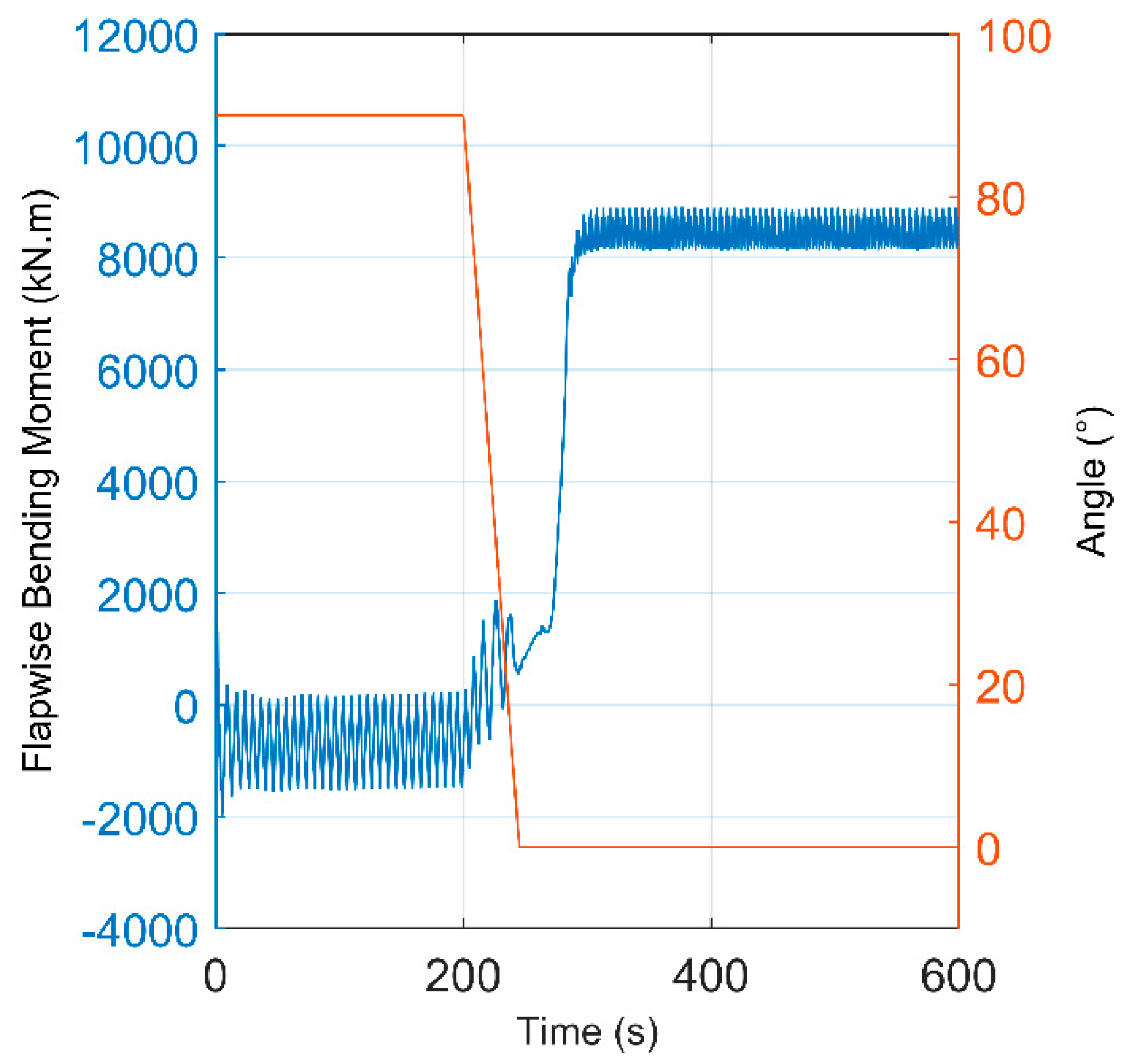
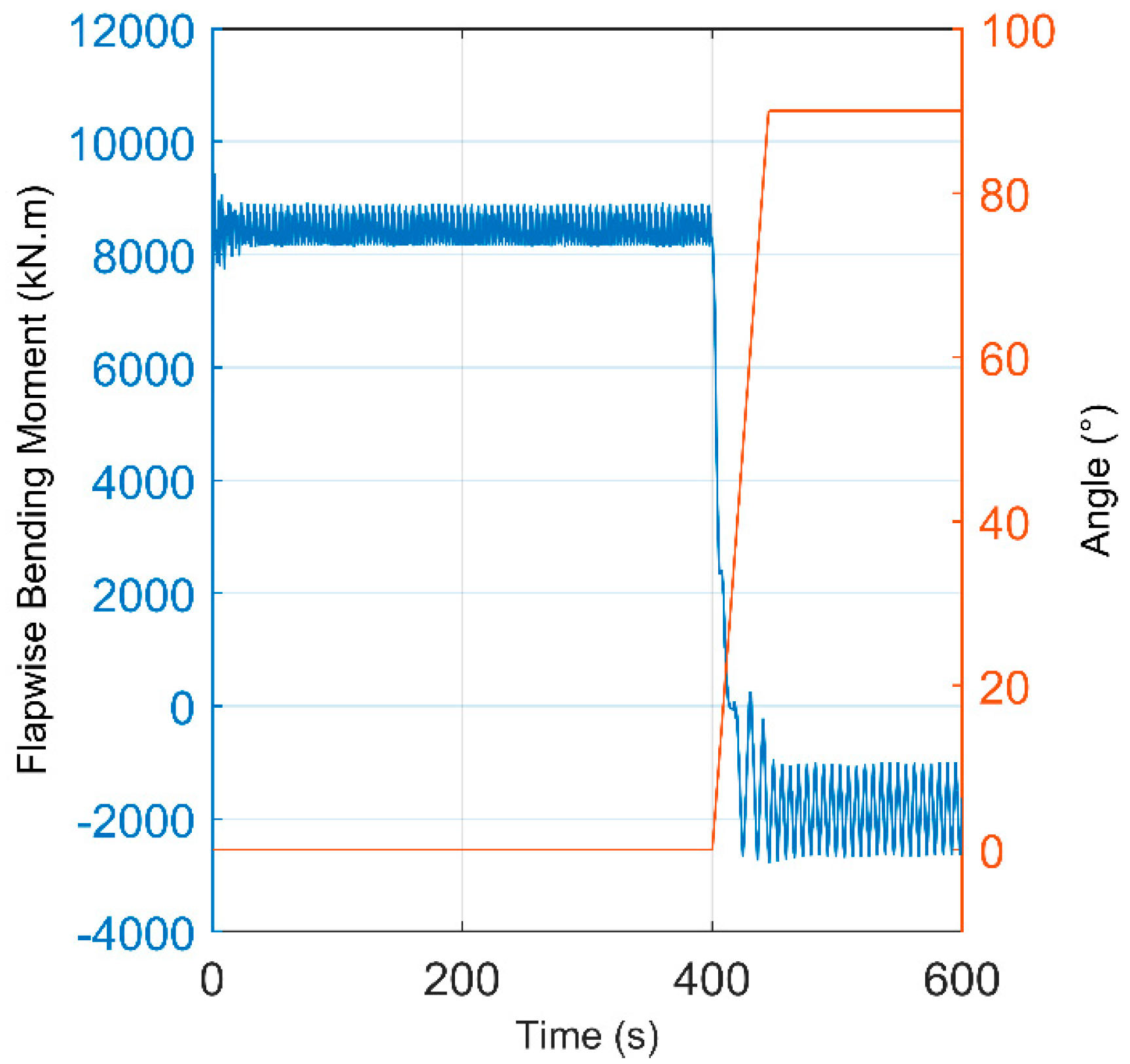
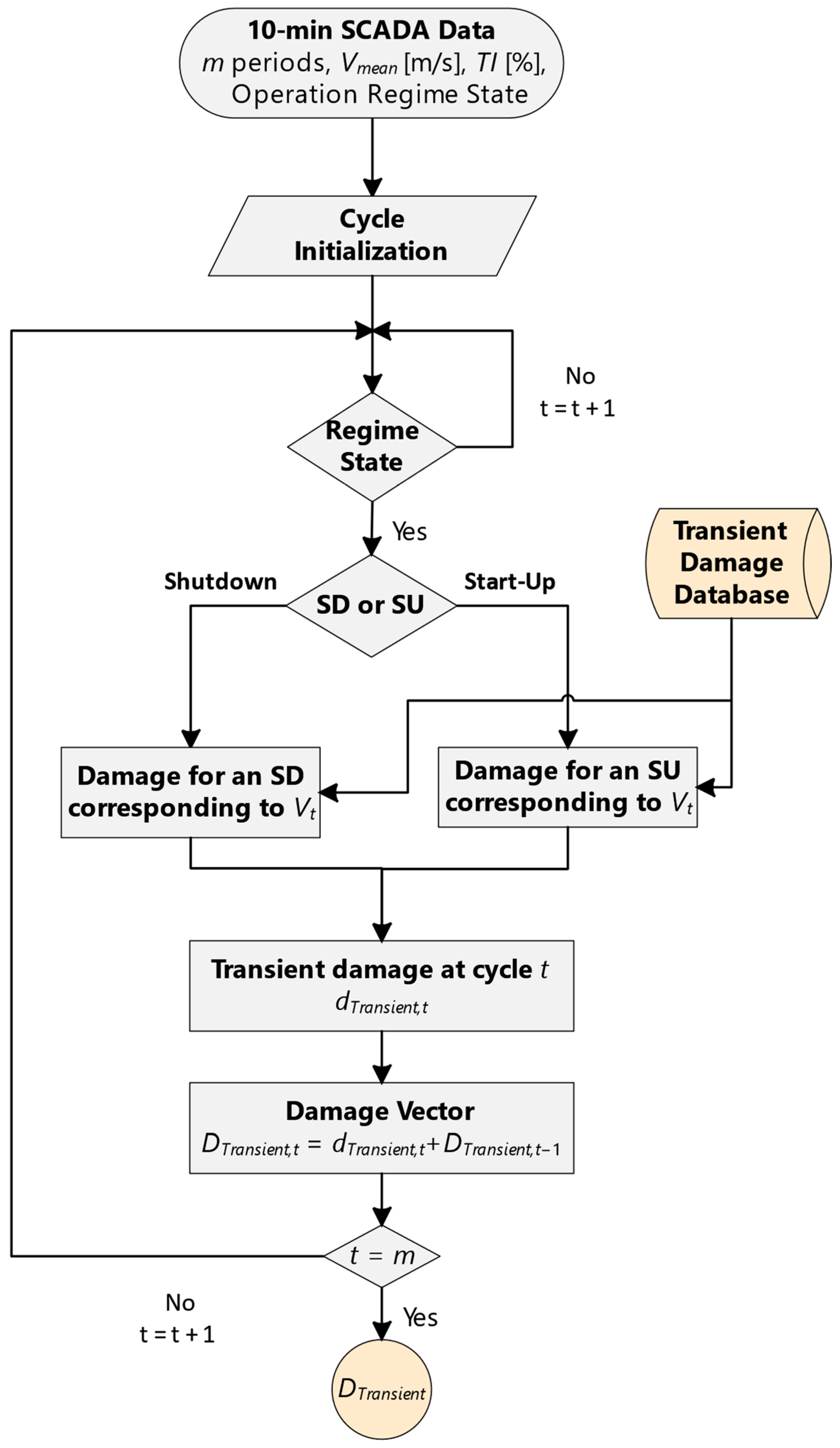
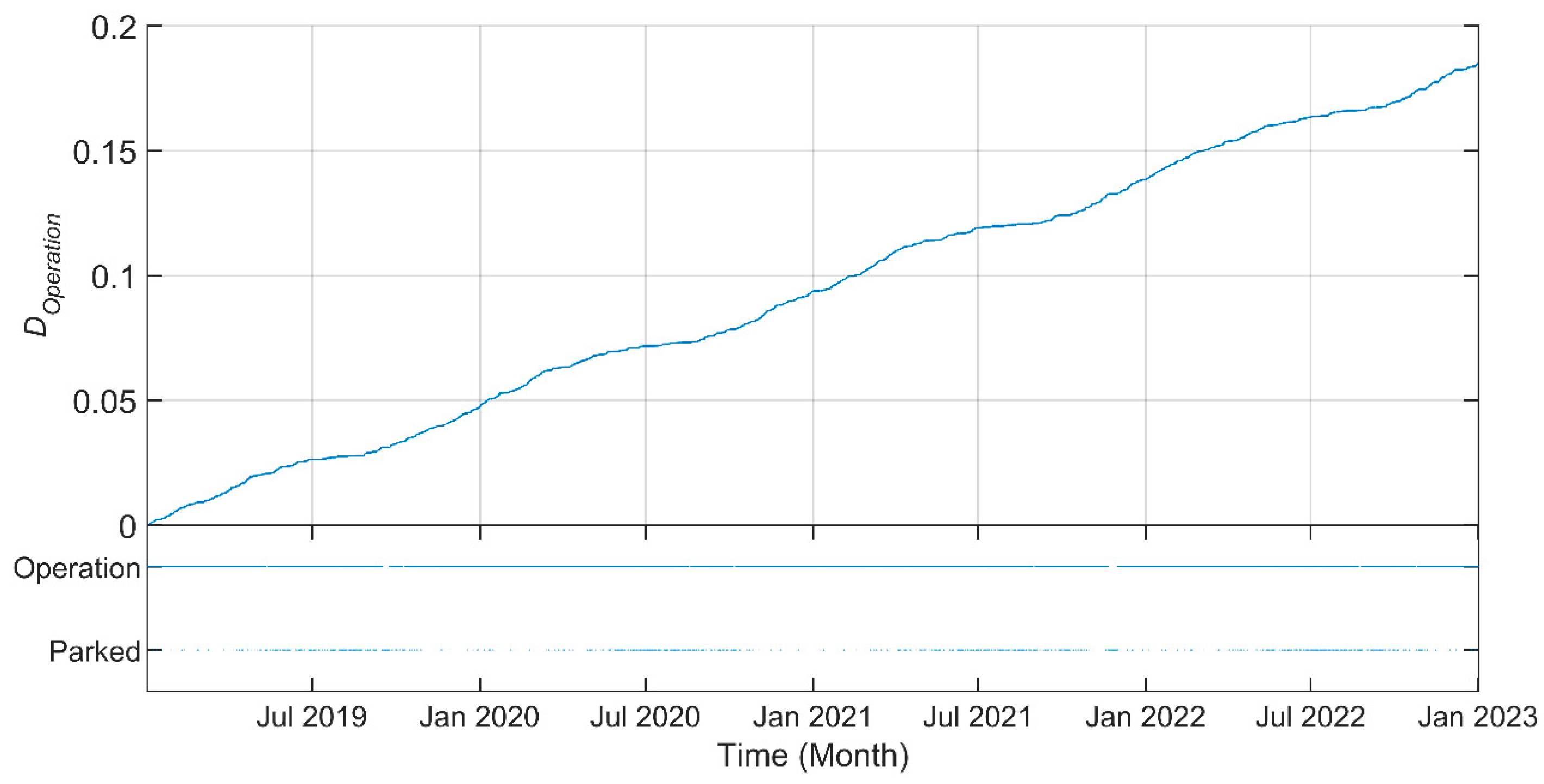
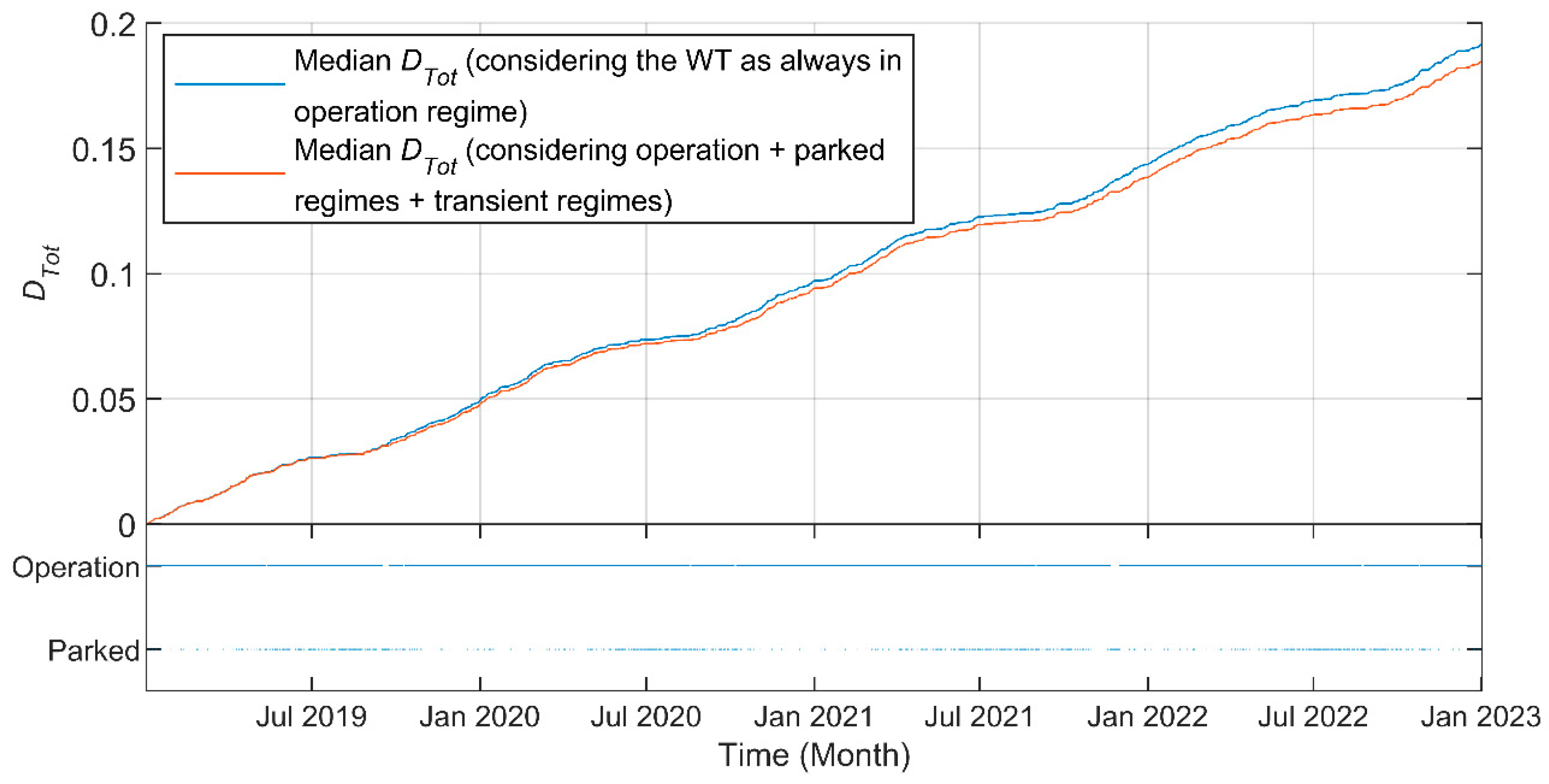
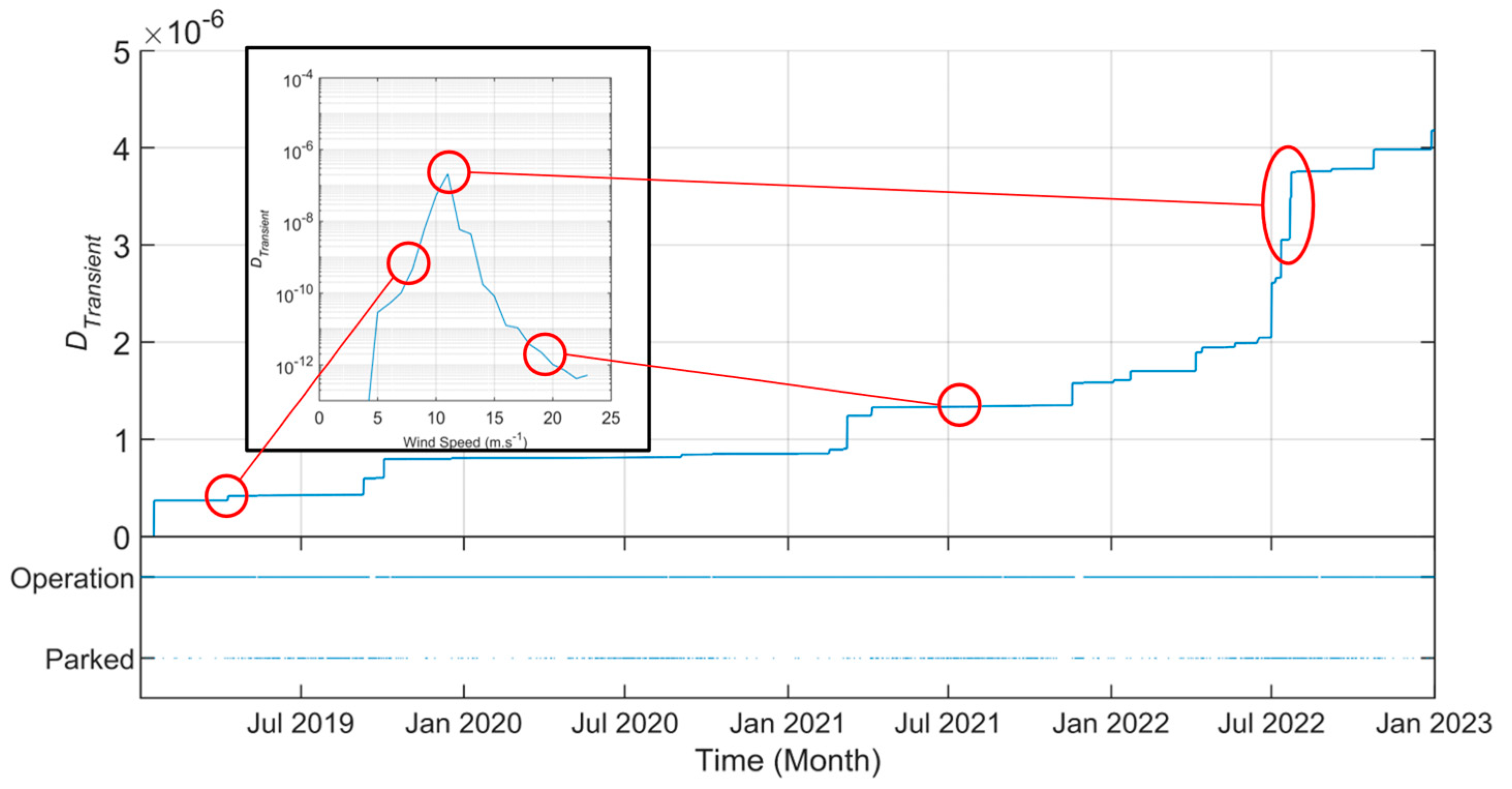
| Damage Category | Absolute Damage Value for a 4-Year Period | Percentage of Global Damage for a 4-Year Period |
|---|---|---|
| <0.1% | ||
Disclaimer/Publisher’s Note: The statements, opinions and data contained in all publications are solely those of the individual author(s) and contributor(s) and not of MDPI and/or the editor(s). MDPI and/or the editor(s) disclaim responsibility for any injury to people or property resulting from any ideas, methods, instructions or products referred to in the content. |
© 2024 by the authors. Licensee MDPI, Basel, Switzerland. This article is an open access article distributed under the terms and conditions of the Creative Commons Attribution (CC BY) license (https://creativecommons.org/licenses/by/4.0/).
Share and Cite
Chrétien, A.; Tahan, A.; Pelletier, F. Wind Turbine Blade Damage Evaluation under Multiple Operating Conditions and Based on 10-Min SCADA Data. Energies 2024, 17, 1202. https://doi.org/10.3390/en17051202
Chrétien A, Tahan A, Pelletier F. Wind Turbine Blade Damage Evaluation under Multiple Operating Conditions and Based on 10-Min SCADA Data. Energies. 2024; 17(5):1202. https://doi.org/10.3390/en17051202
Chicago/Turabian StyleChrétien, Antoine, Antoine Tahan, and Francis Pelletier. 2024. "Wind Turbine Blade Damage Evaluation under Multiple Operating Conditions and Based on 10-Min SCADA Data" Energies 17, no. 5: 1202. https://doi.org/10.3390/en17051202
APA StyleChrétien, A., Tahan, A., & Pelletier, F. (2024). Wind Turbine Blade Damage Evaluation under Multiple Operating Conditions and Based on 10-Min SCADA Data. Energies, 17(5), 1202. https://doi.org/10.3390/en17051202






